
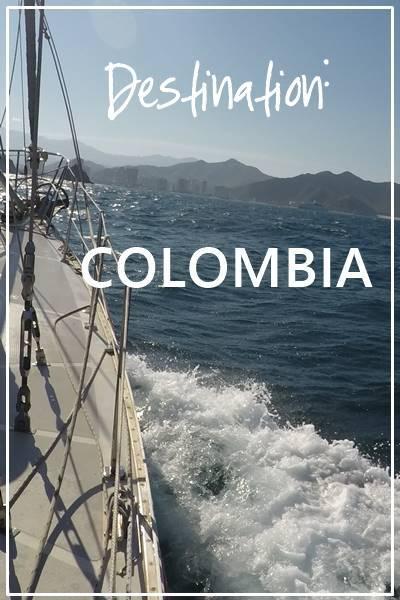
It wasn’t many years ago that Colombia was considered dangerous to visit: cruisers lured by pretty Venezuelan islands towards South America rarely made the hop next door. While care must be taken, the story has flipped: improved domestic stability makes Colombia a relatively secure destination and economic collapse had turned Venezuela into a no-go zone.
We arrived in Santa Marta, Colombia with plans to stay not much more than a week: just long enough for Jamie to fly up to Puerto Rico for rigging work on a friends’s boat, a quick overland trip to Cartagena, and then we’d be off. Delays getting watermaker parts threw a wrench in that (what started as an overnight delivery from St Thomas to Puerto Rico took nearly three weeks to reach us in Colombia). That’s just part of cruising, and it turns out it was a gift: there was more to enjoy every day we extended. Here’s what stands out: the landscape, people, food, culture, and more that made Colombia a vibrant and memorable stop.
Sierras not seas
Cruising gives us many opportunities to experience warm, clear water and sunny clean beaches…neither of which are abundant in the Colombia we saw. Sewage from Santa Marta runs into the bay, and while the beaches were packed with domestic holiday goers in December and January—they didn’t look much more appealing than the water. On the other hand: as a visitor, Colombia’s inland scenery is stunning. Among the highest coastal mountain ranges in the world, the Sierra Nevada present a dramatic horizon upon arrival and beg exploring.
Weaving into the foothills on a two-lane road, bustle of Santa Marta faded with startling rapidity and the quiet rhythm of early morning in the countryside descended. Mairen, Siobhan and I traveled a couple of hours east to Buritaca for horseback riding, fulfilling a Christmas promise. Clearing the limits of town, gaining altitude, the jungle crept closer. Villages sprang up as clusters around the main road and enveloped our senses. Just steps from the narrow motorway were vendors cooking fragrant sausages over charcoal, flipping the ubiquitous arepa (a maize flour patty) on a griddle, and serving hot tinto (Colombian coffee) to wash them down. At one roadstead stop, a Kogi family—an indigenous people to the Sierra Nevada—got in, startlingly different in all-white homespun clothes, small stature and features. Mere days into our stay, it was startling to see indigenous people preserving what appeared to be a strictly traditional way of life despite close access to development.
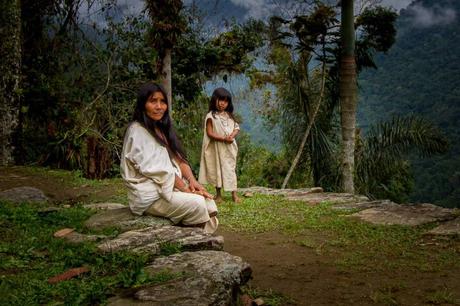
Photo, Dwayne Reilander; licensed under the Creative Commons Attribution-Share Alike 4.0 International
Rio Buritaca runs from the Sierra Nevadas to the ocean. Our ride was planned for time on the beach and time in the river, but king tides took most of the beach away (temporarily!) and heavy rains overnight made horses balk at the swollen rio. Jungle trail it is, then!
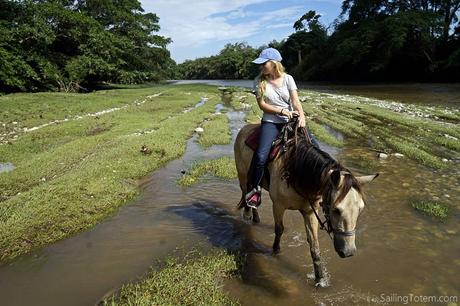
Mairen has always felt perfectly at home on the back of a horse
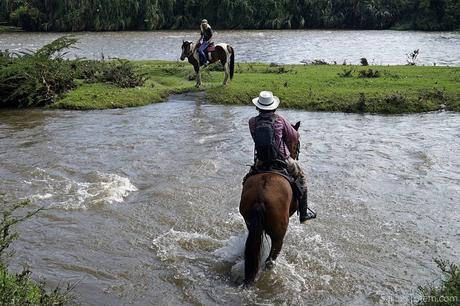
Siobhan’s horse refused to cross one edge of the river until led by the guide
Another morning we headed directly inland to Minca, a village almost directly inland at about 2,000’ elevation. Again, the city quickly fell away: hiking to visit an organic coffee plantation opened spectacular views.
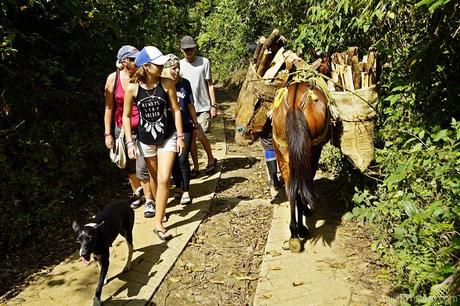
On the trail with the Utopia II crew… and horses carrying firewood

Up into the clouds: at least the elevation kept the temperature down.
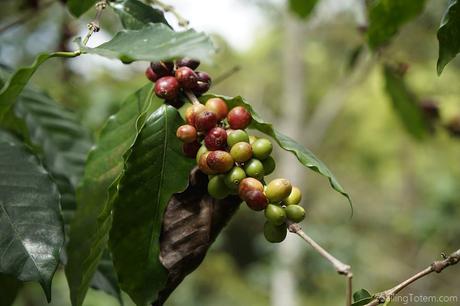
Coffee ripening at the organic ‘finca’ (farm) of La Candelaria
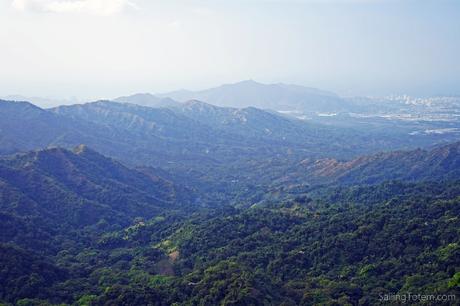
In each case, the buses were cheap- just a few dollars to be transported into a new and marvelous landscape. For cruisers with more time and bigger budgets, the Ciudad Perdida (Lost City) is a four to six-day trek into these mountains to an archaeological site that predates Machu Picchu, more than 20 miles through the mountains and Kogi villages. Probably abandoned during the Spanish conquest, it was once a city of thousands.
Historic and cultural interest
Indigenous tradition layered with Spanish influence create a richer, more nuanced, and vibrantly presented way of life than we’ve seen in a long time. For all their unique qualities, after a while I confess that many of the Caribbean islands blend together as variations on a theme: it seems our traveling spirits thrive on learning from the new. Colombia was a welcome whiplash of streaming language, arts, literature, history… all playing into the experiences awaiting. And then, the Old Town in Cartagena de Indias is simply spectacular. A couple of days there was only enough to tease.
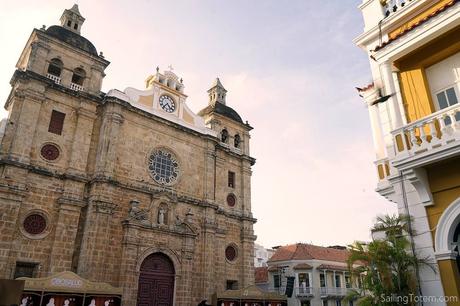
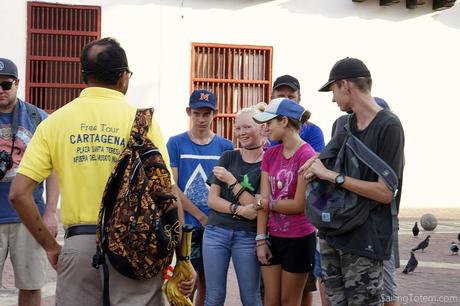
Kids listen (mostly) to the Cartagena Free Tours guide in Old Town: more informative than the tour we paid for!
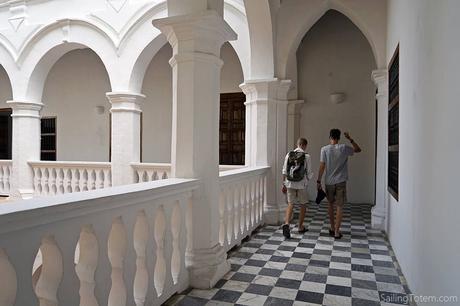
Cartagenas inquisition museum, the seat of a perfect record for executing 100% of those accused of witchcraft or heresy – 800 over about 250 years
Culinary imprint
Tastes enhance the memory of a place, and Colombia added a few in particular. You cannot go to Colombia without eating arepas (well, you could, but it would be very wrong!). My favorite was con huevo, a fried egg tucked within; con queso a close second. Paired with a sizzling chorizo from a streetside vendor, that’s better fast food than any chain!
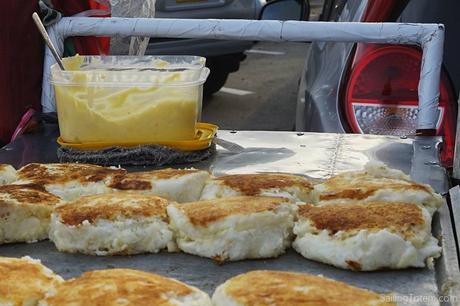
Arepas vary regionally: these thicker cheese arepas were sold on the street in Cartagena.
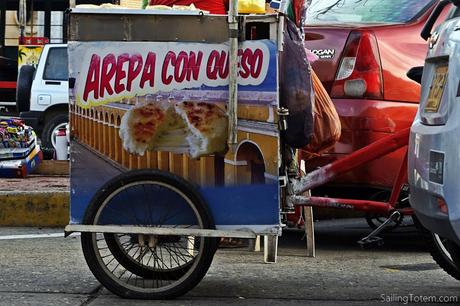
Patacones (twice-fried green plantain slices) are standard accompaniments to a meal. Colombia produces more arabica beans than any country in the world, and coffee is woven into culinary culture: vendors push carts laden with thermoses down the street, paused by Colombianos to buy a caffeine jolt in small cups.
We fell into the habit the Almuerzo Ejecutivo, Executive Lunch. It includes a soup starter, a main course of rice, beans, patacones, and your choice from the chalkboard selection of the days stews and grilled meat, and served with a fresh juice. It costs less than a Starbucks coffee. Perhaps the bandeja paisa, farmer’s plate, a sampler with a range of dishes (below) is more; still less than a latte. Shoehorned in among lively tables in establishments set up in the street front room of a family home (restaurant sign optional), listening to street musicians play for small change while taste buds were treated to a sampler of Colombian cooking.

Colombian lunch of champions, the Bandeja Paisa: SO GOOD
Affordable
After so many months in more expensive Caribbean islands, it was good to be in back in low-cost-of-living territory. Groceries are a big chunk of our monthly budget, and Colombia helped bring the average down again. It also afforded little luxuries we’d forgo elsewhere. Multi-course lunch? Around $3-$4. Why not get a break from cutting my own hair when a fancy salon is just $11, including the coffee? Packed kebabs from a street vendor—marinated beef, chicken, and vegetables—only a dollar? One per person carried steaming back home to Totem made for an easy dinner.
On the other hand: staying in the marina, a security necessity, was not cheap…but could have been worse.
Warm people
At every turn Colombians were engaging and helpful. Our Spanish is basic at best, and in everyday life the Colombians we met rarely spoke English. It wasn’t an obstacle: friendliness and interest saw every interaction through, with a little help from Google translate and a pocket dictionary. When I had my hair cut in a salon, none of the staff spoke English but found another patron who could translate enough to ensure they understood my wishes. Our Spanish skills improved daily.
Arriving between Christmas and New Year’s opened a peek into a vital, family-centered domestic life. Santa Marta is a destination for Colombians on holiday, and they know how to take time out: the beach was packed with families. Vendors pitching tourists weren’t focused on hawking wares to us gringos as much as their fellow sudamericanos. It was hard to tell weekends from weekdays in the busy marina, where local powerboats daily transported multi-generational families with coolers and platters and nightly cranked up the tunes for dockside entertainment.
It’s always about the people, isn’t it?
More to follow on our experiences in Colombia…meanwhile a few more pictures.
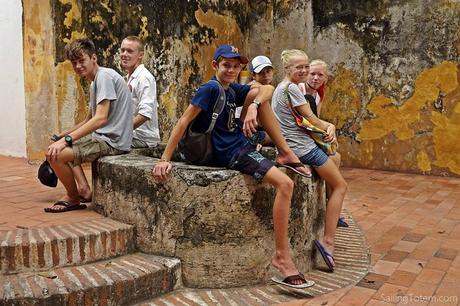
Kids displaying classic ABM face – Another Bloody Museum
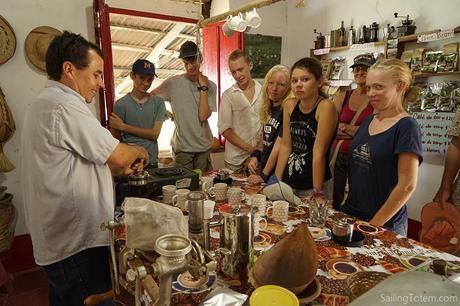
Third-generation coffee grower sharing his favorite method to prepare the beverage… what do you think?

Resident toucan at La Candelaria.
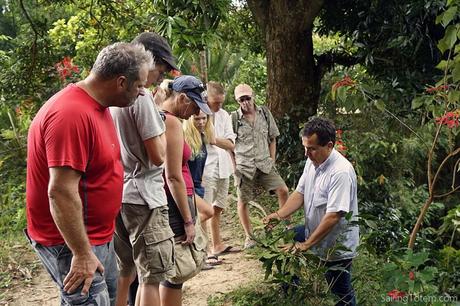
An education on politics, economics, agriculture learning about the farm.

